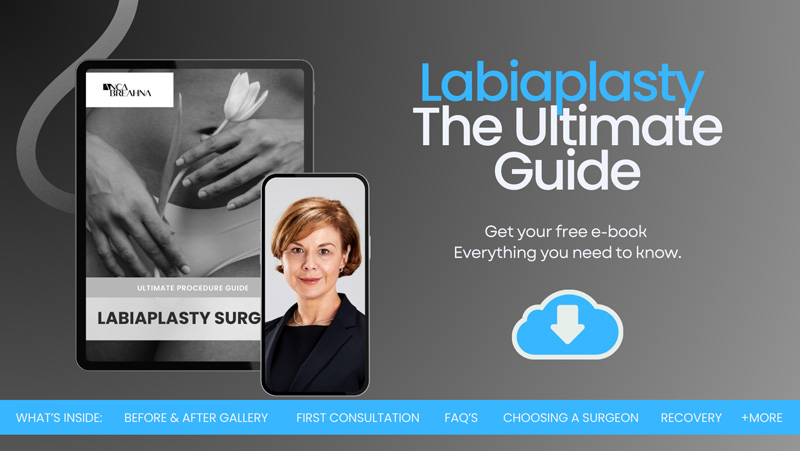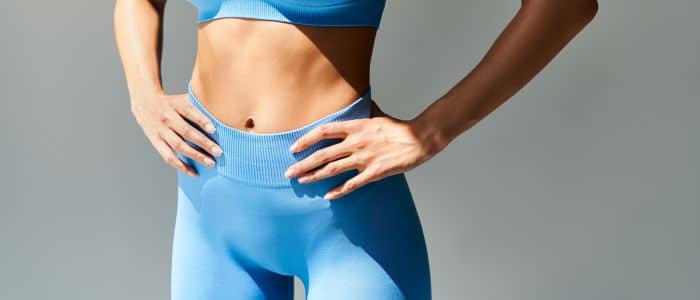
Table of Contents
- When and How to Resume Exercising after Labiaplasty
- Download Anca Breahna’s Labiaplasty Guide
- More about Labiaplasty
- Post-Surgery: The Initial Recovery Phase
- Week 1-2: Gentle Mobilisation
- Week 3-4: Gradual Increase in Activity
- Gentle, Low-Impact Exercises
- Important Considerations
- Week 5-6: Introducing Moderate Exercise after Labiaplasty
- Safety Tips and Considerations
- Week 7-8: Assessing Readiness for Regular Exercise after Labiaplasty
- FAQs about Resuming Exercise after Labiaplasty
- Further Reading about Procedures at Cheshire Cosmetic Surgery
When and How to Resume Exercising after Labiaplasty
Undergoing labiaplasty can be a significant decision for many women, often driven by discomfort, aesthetic concerns, or medical reasons. As a Consultant Plastic Surgeon, Anca understands the importance of not only the surgery itself but also the recovery process, including when and how to reintroduce exercise after labiaplasty.
In this blog, Chester Consultant Plastic Surgeon Anca Breahna aims to provide clear, supportive advice for those navigating the post-operative journey.
Download Anca Breahna’s Labiaplasty Guide

More about Labiaplasty
Labiaplasty, a specialised surgical procedure, is primarily focused on the reshaping or reduction of the labia minora, the inner folds of the vulva. This surgery has gained increasing attention and popularity in recent years, driven by a combination of functional and aesthetic reasons. Women may seek labiaplasty for different reasons, ranging from discomfort caused by enlarged labia during physical activities or wearing certain clothing, to personal dissatisfaction with the appearance of their genital area.
Post-Surgery: The Initial Recovery Phase
The initial 24-48 hours following a labiaplasty procedure are critical in setting the stage for a smooth and successful recovery. This period is characterised by rest and a significant reduction in physical activity, allowing the body to begin the healing process.
During these first few days, patients can expect to experience swelling and discomfort in the treated area. It’s important to understand that these symptoms are a normal part of the healing process. The extent of swelling and discomfort can vary from person to person, influenced by factors such as the individual’s pain threshold, the specific techniques used during surgery, and the body’s natural response to the trauma of surgery.
To manage these symptoms effectively, it is essential to follow the pain management plan prescribed by Anca. This may include medications for pain relief and to reduce inflammation. It’s crucial to take these medications as directed, both to alleviate discomfort and to prevent potential complications.
Week 1-2: Gentle Mobilisation
The first two weeks post-labiaplasty are an important period in the healing process, where the primary focus should be on gentle mobilisation and careful recovery. During this time, it’s important to balance rest with light activity to promote optimal healing.
- Light Walking: Engaging in light walking around the house is highly recommended during this phase. This gentle form of exercise is beneficial for several reasons. Firstly, it helps in maintaining good blood circulation, which is essential for wound healing and reducing the risk of blood clots, a potential complication after any surgery. Walking should be slow and measured, avoiding any brisk or prolonged activity that could put undue pressure on the healing tissues
- Avoiding Strenuous Activity: It’s imperative to avoid any strenuous activities or exercises that could strain the surgical area. This includes lifting heavy objects, engaging in high-impact exercises, or any form of vigorous workout. Such activities can not only cause pain and discomfort but also increase the risk of complications such as wound dehiscence (reopening of the surgical wound) or exacerbated swelling
- Posture and Movement: Paying attention to posture and the way you move is also important. Avoid positions or movements that put direct pressure on the healing area. When sitting, for instance, using a soft cushion or a donut pillow can help alleviate pressure on the surgical site
- Gradual Increase in Activities: As you progress through the first two weeks, you can gradually increase your level of activity, but this should be done cautiously. Listen to your body and take note of any discomfort or unusual symptoms. If you experience increased pain, swelling, or any other concerning symptoms, it’s advisable to reduce your activity level and consult Anca
Week 3-4: Gradual Increase in Activity

As you enter weeks 3 and 4 of your recovery from labiaplasty, your body has begun to heal significantly. This phase allows for a gradual increase in activity levels, introducing gentle, low-impact exercises that promote further healing and well-being without straining the surgical area.
Gentle, Low-Impact Exercises
- Extended Walking: You can now extend your walking sessions, both in duration and distance. Consider leisurely walks in a park or around your neighbourhood. The key is to maintain a pace that is comfortable and does not cause any discomfort in the surgical area
- Light Yoga: Gentle yoga can be very beneficial at this stage. Focus on poses that do not put pressure on the pelvic area. Poses like Cat-Cow, gentle seated stretches, and leg lifts can improve flexibility and circulation without straining your recovery. Avoid any asanas that involve intense stretching or pressure on the pelvic region
- Pilates: Pilates, particularly mat-based routines, can be a good option. Exercises that focus on core strength and stability can be beneficial, as long as they do not involve direct pressure on the healing tissues. Simple leg circles, pelvic tilts, and other low-impact core exercises can be incorporated
- Swimming: If your wounds are completely healed and you have the go-ahead from your surgeon, swimming can be a great exercise. Water provides a low-impact environment for gentle exercise. Start with slow, leisurely laps in the pool, avoiding any vigorous strokes
- Stationary Cycling: A stationary bike can be used for light cycling. Ensure the seat is comfortable and avoid putting too much pressure on the surgical area. Start with a low resistance setting and a short duration, gradually increasing as comfort allows
- Tai Chi or Qigong: These gentle martial arts focus on slow, deliberate movements and can be excellent for improving balance and relaxation without straining your body
Important Considerations
- Listen to Your Body: The most crucial aspect during this phase is to listen to your body. If you experience any pain, discomfort, or unusual symptoms while exercising, it’s important to stop immediately and consult with Anca
- Avoid High-Impact Activities: Activities that involve jumping, running, or vigorous aerobic exercises should still be avoided, as they can put too much strain on the healing tissues
- Gradual Progression: Increase the intensity and duration of your exercises gradually. Do not rush into longer or more strenuous workouts too quickly
- Hydration and Nutrition: Continue to support your body with proper hydration and a balanced diet rich in nutrients that aid in healing and energy
Week 5-6: Introducing Moderate Exercise after Labiaplasty
As you progress into weeks 5 and 6 of your recovery from labiaplasty, and if your healing is proceeding well, you can start to introduce moderate exercises into your routine. This phase is about gently increasing the intensity of your workouts while still being mindful of the healing process. Here are some examples of moderate exercises and tips on how to perform them safely:
- Brisk Walking: You can now increase the pace of your walks. Aim for a brisk pace that elevates your heart rate but doesn’t cause discomfort in the surgical area. Try to walk for at least 20-30 minutes, ensuring you have supportive footwear. Walking in nature or in a peaceful environment can also provide mental health benefits
- Light Cycling: Gradually increase the duration and intensity of your cycling sessions. If you’re using a stationary bike, you can start to add mild resistance. For outdoor cycling, choose flat, smooth paths to avoid jarring movements. Always ensure the bike seat is comfortable and doesn’t put pressure on the healing area
- Mild Aerobic Workouts: Begin with low-impact aerobic exercises. You can follow a light aerobic workout video or join a class designed for beginners. Focus on movements that increase your heart rate without involving jumping or high-impact steps. Exercises like step-touches, gentle marching in place, and arm circles can be incorporated
- Swimming: If you haven’t started swimming in the earlier weeks and have the all-clear from Anca, swimming can be a great moderate exercise. Try doing some gentle freestyle or breaststroke laps, avoiding vigorous or high-speed swimming
- Elliptical Trainer: The elliptical trainer is an excellent way to engage in a cardiovascular workout without the high impact of running. Start with a low resistance setting and a comfortable pace. Ensure that you maintain good posture and don’t overstrain
- Bodyweight Exercises: Introduce simple bodyweight exercises such as wall push-ups, seated squats, and leg lifts. These exercises can help in building strength without putting excessive strain on your body. Remember to focus on form and controlled movements
- Pilates and Yoga: You can now try slightly more advanced Pilates and yoga exercises, but continue to avoid poses and movements that put direct pressure on the pelvic area. Poses like the Warrior series, Bridge pose, and modified Planks can be beneficial
Safety Tips and Considerations
- Warm-Up and Cool-Down: Always start your exercise after labiaplasty session with a warm-up and end with a cool-down to prevent injury and aid muscle recovery
- Hydration: Stay well-hydrated before, during, and after exercise after labiaplasty. Proper hydration is essential for overall health and aids in recovery
- Listen to Your Body: Pay close attention to how your body responds during and after exercise. Any sign of pain or discomfort in the surgical area should be taken seriously. If you experience any adverse symptoms, reduce the intensity or stop the activity
- Avoid High-Impact Activities: Continue to avoid high-impact activities such as running, jumping, or heavy lifting, as they can put too much stress on the healing tissues
- Progress Gradually: Increase the intensity and duration of your workouts gradually. Avoid the temptation to jump back into pre-surgery exercise levels too quickly
- Consult Your Surgeon: Keep in regular contact with Anca, especially if you’re unsure about which exercises are safe for you at this stage of recovery
Week 7-8: Assessing Readiness for Regular Exercise after Labiaplasty
As you approach weeks 7 and 8 of your recovery from labiaplasty, it’s time to assess your readiness for returning to your regular exercise routine. This phase is important for ensuring that your body is sufficiently healed and capable of handling more intense physical activities.
Follow-Up Consultation with Your Surgeon
- Assessment of Healing: Schedule a follow-up consultation with Anca to evaluate your healing progress. She will examine the surgical area to ensure that it has healed properly and that there are no signs of complications such as infection or prolonged swelling
- Professional Guidance: During this visit, discuss your exercise plans with Anca. She can provide tailored advice based on your specific recovery and any unique aspects of your surgery
- Addressing Concerns: This is also an opportunity to address any concerns or questions you may have about your recovery and physical activities
Reintroducing Regular Exercise after Labiaplasty
- Start Slowly: If you receive approval from your surgeon, begin reintroducing your regular exercise routine gradually. It’s important not to rush this process. Start with lower intensity versions of your usual workouts
- Monitor Your Body’s Response: Pay close attention to how your body responds during and after exercise. Any pain, discomfort, or unusual symptoms in the surgical area should be taken seriously. If you experience any of these, it may be a sign to reduce the intensity or take a break
- Gradual Intensity Build-Up: Gradually increase the intensity and duration of your workouts over time. For instance, if you were a runner before your surgery, start with light jogging or a brisk walk, then slowly build up to your regular pace and distance
- Incorporate Variety: Include a mix of cardiovascular exercises, strength training, and flexibility workouts. This balanced approach helps in overall fitness and reduces the risk of overstraining any particular part of your body
- Strength Training: If strength training was part of your routine, start with lighter weights and fewer repetitions. Gradually increase the weight and intensity as your comfort and strength improve
- High-Impact Exercises: For high-impact exercises like running, aerobics, or sports, ensure that you feel no discomfort during or after the activity. It’s better to err on the side of caution and progress more slowly with these types of exercises
Additional Tips
- Stay Hydrated and Nourished: Continue to support your body with adequate hydration and a nutritious diet, which are essential for maintaining energy levels and aiding in recovery
- Rest and Recovery: Even as you increase your activity levels, remember that rest is still an important part of the recovery process. Ensure you are getting enough sleep and giving your body time to recuperate
- Listen to Your Body: The most important aspect during this phase is to listen to your body. It will give you signals if you are pushing too hard or if you are on the right track
By carefully assessing your readiness for regular exercise and gradually reintroducing more intense physical activities, you can ensure a safe and effective return to your pre-surgery fitness routine. Keep in mind that every individual’s recovery timeline is different, so it’s important to tailor your approach to your personal circumstances and Anca’s advice.
FAQs about Resuming Exercise after Labiaplasty

How soon can I start doing yoga after my labiaplasty?
You can start with gentle yoga movements as early as 3-4 weeks post-surgery, focusing on poses that do not put pressure on the pelvic area. Keep in mind that it’s important to wait until you are at least 6-8 weeks post-surgery before attempting more strenuous yoga poses or any asanas that involve stretching or pressure in the surgical area. Always follow your surgeon’s advice and listen to your body’s signals.
Is it safe to do abdominal exercise after labiaplasty?
Light abdominal exercises, such as pelvic tilts or gentle core strengthening, can usually be resumed around 4-6 weeks post-surgery, provided they do not cause discomfort in the surgical area. It’s advisable to avoid intense abdominal workouts like crunches or planks until you are fully healed and have received clearance from Anca, usually around 8 weeks post-surgery.
When can I resume high-intensity interval training (HIIT) after labiaplasty?
High-intensity interval training should be approached with caution and is generally not recommended until you have fully recovered. This type of training is usually safe to resume around 8-10 weeks post-surgery, but only after you have gradually built up your exercise tolerance with lower-impact activities and have received the go-ahead from your surgeon.
Can I go back to playing sports after labiaplasty?
Returning to sports should be a gradual process. Depending on the nature of the sport, you can usually start reintroducing light sports activities around 6-8 weeks post-surgery. Sports that involve running, jumping, or contact should be approached with caution and only resumed once you feel no discomfort during or after the activity and have your surgeon’s approval.
Are there any specific exercises I should avoid permanently after labiaplasty?
There are no specific exercises that need to be permanently avoided after a labiaplasty, as long as you have fully healed and have been cleared by your surgeon. But it’s always important to approach exercises that put direct pressure on the pelvic area with caution, even after full recovery. Listen to your body and avoid any activities that cause discomfort or pain in the surgical area.
Medical References about Labiaplasty Surgery
- Labiaplasty (vulval surgery) – NHS: https://www.nhs.uk/tests-and-treatments/cosmetic-procedures/cosmetic-surgery/labiaplasty/
- Labiaplasty | Aesthetic Genital Plastic Surgery – ASPS: https://www.plasticsurgery.org/cosmetic-procedures/aesthetic-genital-plastic-surgery/labiaplasty
- Labiaplasty Minora Reduction – StatPearls: https://www.ncbi.nlm.nih.gov/books/NBK459223/
- A Retrospective Study of the Psychological Outcomes of Labiaplasty: https://pubmed.ncbi.nlm.nih.gov/28541991/
- Safety of Aesthetic Labiaplasty: A Plastic Surgery Experience: https://pubmed.ncbi.nlm.nih.gov/30789886/
Further Reading about Procedures at Cheshire Cosmetic Surgery
- Read more about Labial Hypertrophy – Enlarged Labia
- Read more about Labiaplasty
- Read more about Aqualyx (Fat Dissolving Injections)
- Read more about Desirial Injections (Vaginal Dryness)
- Read more about Labiaplasty Types – Trim Labiaplasty and Wedge Labiaplasty or Hybrid
- Read more about Treatments and Solutions for Sagging Vulva
- Read more about 10 Questions to Ask Your Surgeon before Labiaplasty Surgery






